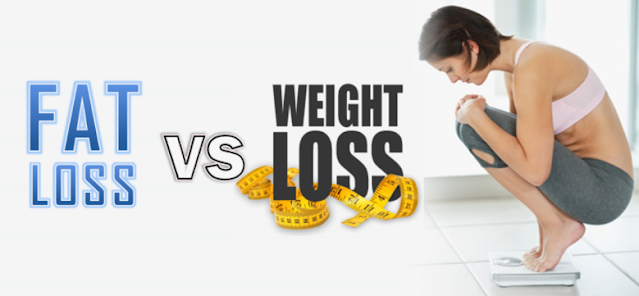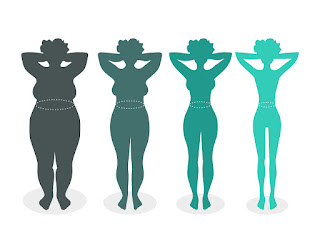Fat loss vs. Weight loss :Why Weight Loss is Making You Fatter
We are so attached to the eat less, exercise more weight loss model. We quickly reject the very thought that something might work better than counting calories, eating like a bird, better willpower or running marathons. Allowing yourself that one more bite launches an uncomfortable reaction, upset, angst, worry, and fear of failure.
But maybe you should eat more calories to lose weight! Could it be true? Is it possible to eat more and lose weight?
Yes! It may even be necessary!
Fat loss vs. Weight loss
Loss from counting calories: Sure, you will lose weight by eating 500 calories a day and running for miles, but the weight you lose and calories you burn may or may not be fat. Your shape won’t change to become the toned, healthy, athletic body you seek. An oval body will simply become a smaller oval; a pear, a smaller pear… and a mushier one too!
The “eat less, exercise more” weight loss model is a game that’s nearly impossible to win. Not only does it not sculpt your body, it has as the terrible consequence of weight gain rebound; the “yo-yo diet”.
Weight loss reduces muscle and tone while increasing fat:
The standard low-calorie diet makes it far more likely you will not only regain the weight you lost, but end up fatter than you were before. The insatiable hunger, relentless cravings, and emotional angst and deprivation, almost guarantees a return to our bigger, fatter selves. (see references 1-7 below).
The long term success rate of this approach is less than 5% according to medical research. FIVE percent! of everyone who tries the calorie-counting approach actually achieve and maintain their goals.
Yet every day we hear an endless stream of promotion for weight-loss shakes, cardboard pre-packaged low-calorie meals-in-a-box (child-like portions), diet fads, diet books, pills, injections and other schemes… made by the very companies that sell you the other food—the food that makes you fat. There is such non-stop promotion of deliberate weight loss misinformation it is hard to believe only 5 percent of those who buy in actually achieve their weight goals and keep them long term.
Research also tells us that 66% of individuals who take this approach end up fatter within 2 years after their diet. Wow!
In the short run counting calories may make you smaller, but any plan that only works long enough to get a punchy testimonial for the vendor yet is impossible to maintain in the long-run, is not a plan that works. and for those few who succeed, keeping the weight off is an exhausting, continuous battle against willpower.
The calorie weight loss game is not a rewarding or even healthy approach to permanent body change.
Hormonal Fat Loss:
Stably losing fat requires a hormone centered approach. It pays particular attention to energy-burning and energy-storing hormones—not just calories.
You can’t exercise your way out of poor nutrition!
Forget complex science and more importantly forget fancy blood tests. You don’t need these to tell you if your hormones are balanced for fat loss. In fact, I even hesitate to mention any hormone names because someone will decide to go order some fancy blood tests, most of which are not something you can interpret based on just one test anyway. In fact, if there is anything universally true—it is that nothing operates by itself; the only way to interpret medical tests is by looking at the big picture and complete test panels. But I digress…
How do you know if your body is set up for a fat-burning hormone state? Listen to it! When you eat foods that are correct for your body; when you give your body all the nutrients it needs; it doesn’t crave anything, it has plenty of energy, and you don’t feel hungry again for many hours.
When your hormonal metabolism is balanced these three biofeedback tools will also be balanced: hunger will be reduced, energy will be balanced, and cravings will be almost absent. When metabolism is functioning optimally, you feel right—and you don’t need a fancy test to tell you this.
But Doc, I listened—my body asked for comfort food!
Right; this is a hormone-imbalanced state. And when you aren’t balanced, just try to eat less and move more. A whole interplay of numerous hormones pushes your body into starvation mode, you feel hungry, emotionally deprived, the body shuts down and conserves energy (you feel tired, certainly not motivated to exercise, cranky, out of balance) and eventually this gets the best of even the biggest willpower and let the binge begin. But it doesn’t have to be that way.
The approach I take with my patients balances hormones to raise energy, reduce hunger and cravings, and lose fat not muscle. But you must eat more—the right sort of more—and you must, must, must stop the calorie-counting and daily weigh-in game.
Yes, you can do this if you understand your body.
One hormone to understand is called leptin. Secreted by fat cells, leptin sends a signal to the brain that we have enough energy stored and that we don’t need to eat (8). The problem is that when you ignore this, eat anyway, and accumulate more fat, the more fat you have the more leptin you make – making more leptin desensitizes your body and eventually your body becomes “leptin resistant”. When this happens, even though you’ve stored enough fat, your brain never hears the message. Instead, it thinks you are starving and withering away to nothing and good luck fighting this impulse.
Lose fat by eating more: Go on the “un-diet”
Skip the misinformation. Certain foods affect your body and your hormones in key fat-gaining ways. Eating certain foods practically forces your body to make fat-storing, hunger-craving hormones. Even if you currently feel healthy, it is honestly just a matter of time until these five foods create health problems you’ll need to solve with expensive medical bills.
So, first of all, skip these five common diet foods:
- Concentrated fruit juice: Anything that is *just* the juice of a fruit puts your body in fat storage mode. Whether it is a frozen can of orange juice or the liquid squeezed out of organic celery at your favorite juice bar has nearly as much sugar in it as a can of cola. That energy burst you might feel from your juice blast is in part the rush of elevated blood sugar. But what happens next is that your body has to raise insulin to lower the blood sugar to a healthy range—too much blood sugar will kill you. Insulin is a fat storing hormone. In fact, when a person continues down the path to insulin resistance and diabetes from elevating their blood sugar too often, when they need insulin injections, the part of their body where they inject the insulin often becomes more fat than the rest of them.
- Whole wheat bread: surprised? Aren’t whole grains healthful? No, not really. In fact not at all. The studies on wheat and whole grains don’t actually show whether they are healthful or not, just that wheat or other grains aren’t as unhealthy as white flour. First of all, wheat is still a highly refined and highly process food. Cereals, breads, pasta, pizza, muffins, pies, and all those other “comfort foods” are truly just another way to rapidly increase blood sugar, insulin and create fat-storage mode. Re-read point #1.
- Margarine: Loaded with trans-fats, margarine is a direct route to increased toxic chemicals in the body and increases inflammation and fat storage. Not only that, margarine and other unhealthy fats—including too many seed oils—can increase cardiovascular disease and imbalance your cholesterol. Switch to healthy fats like butter from grass-fed cows, olive oil and coconut oil. Inflammation causes fat gain; fat stores toxic chemicals and causes more inflammation.
Pause: the first three things are the typical American breakfast, just add coffee and cream. Then they have the same thing for their mid-morning snack… by noon, their insulin surge has just sabotaging their weight and health goals—for the next 24 hours. Then they do this again, and again… and finally give up on the “I’ve no willpower” wrong reason why.
- Processed soy: another thing many people associate with healthy eating, most information you see about soy is aimed at creating demand to justify huge government subsidies and other commercial agriculture lobbying. Ninety one percent of U.S. grown soy is GMO—made capable of growing in Round-up, therefore highly contaminated with this weed killer. Protein isolated from soy doesn’t seem to affect the body’s hormones in the same way as whey or animal protein. In a study where overweight people were given soy protein, whey protein, or high carbohydrates, grehlin—another eating-signaling hormone, was lower in whey protein group and about the same in the soy and carbohydrate groups. In other words, the type of protein regularly consumed helped lengthen the time between hunger/mealtime cues. And the whey protein group lost more inches. Besides, most of the other soy filler is just the starch, see point on insulin.
- Bananas: And yet another health myth. Unfortunately the poor Dole banana has been hybridized to be much higher in sugar than its ancestral relatives. In fact, too much fruit, even though they still have their fiber unlike drinking just the juices, are still a fast way to increase blood sugar. But before that even happens, all the high sugar foods begin to acidify your digestive tract. This makes a very nice home for yeast, pathogenic bacteria, and even parasites. Your gut becomes inflamed and leaky, stressed.
Ready to lose some weight?
Get back in the kitchen and enjoy the incredibly fresh Alaska farmer’s market produce. Skip the sugarful sauces and meals-in-a-bar. And the next time anyone suggest that something labeled Cream Cheese Cocoa Fudge Cake is a weight loss food, well, you don’t even have to read the label on the back of that one—you already know better.


Comments
Post a Comment